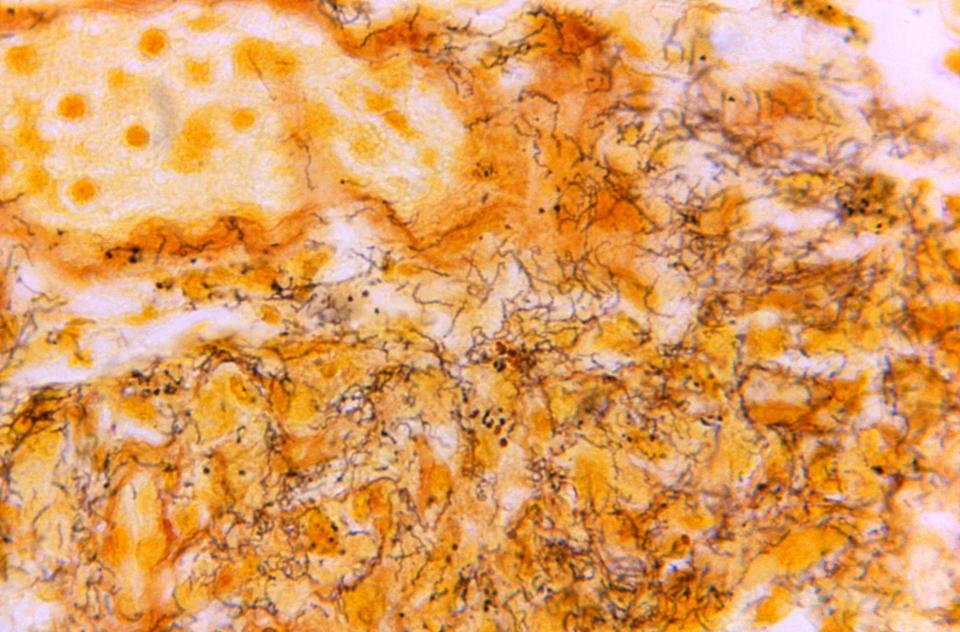Rates of syphilis in the US are higher than anytime since the 1950s, CDC says
The U.S. has a growing sexually transmitted disease problem.
Syphilis cases in 2022 increased to the highest level since 1950, according to a new report, released Tuesday by the Centers for Disease Control and Prevention. In 2022, a total of 207,255 cases of syphilis were reported in the U.S., the CDC report says. Total syphilis cases increased 16.9%, as the rate of reported cases rose from 53.2 per 100,000 in 2021 to 62.2 per 100,000 in 2022.
Especially alarming: Congenital syphilis, which occurs when a mother with syphilis passes the infection on to her baby during pregnancy, increased 30.6% with more than 3,700 cases in 2022.
"We have long known that these infections are common, but we have not faced such severe effects of syphilis in decades," said Dr. Laura Bachmann, acting director of the division of STD prevention at the CDC's National Center for HIV, Viral Hepatitis, STD, and TB Prevention, in a statement accompanying the report. "It has emerged as a unique public health challenge."
The report did reveal some good news. While chlamydia and gonorrhea account for more cases than syphilis – and syphilis is considered more dangerous – the rates of infection of those sexually transmitted diseases (STDs) fell or held steady.
Elon Musk & Neuralink: First patient as a big step. Experts say it's part of long legacy.
Cases of the most common STD, chlamydia, remained the same in 2022 with 1.6 million cases amounting to 495 cases per 100,000 persons – similar to the rate in 2021 of 495.5 per 100,000 in 2021. Chlamydia did increase 1.8% among men, while it declined 1.8% among women, the CDC said.
Gonorrhea declined for the first time since 2009: Total cases fell 9.2% in 2022 to about 648,000 cases. The largest decline came among women (down 14.5%), according to the report.

CDC: Young adults, especially men, more likely to have STDs
Adolescents and young adults aged 15-24 accounted for half (49.8%) of reported cases of chlamydia, gonorrhea, and syphilis, the CDC found. Gay and bisexual men were also more likely to have reported STDs.
About 59,000, or 28% of syphilis cases in 2022 were the infectious forms of syphilis and about a quarter were reported by women and nearly another one-fourth were reported by heterosexual men.
“I think it’s unknowingly being spread in the cisgender heterosexual population because we really aren’t testing for it. We really aren’t looking for it” in that population, Dr. Philip Chan, who teaches at Brown University and is chief medical officer of Open Door Health, a health center for gay, lesbian and transgender patients in Providence, Rhode Island, told The Associated Press.
. Today @CDCSTD released the 2022 #STI Surveillance Report 👉 https://t.co/SzEkJn01xM
Here are four highlights from the #STIreport @CDCgov: (1/5) pic.twitter.com/hMwIrq0Kyn— Dr. Jono Mermin (@DrMerminCDC) January 30, 2024
Opinion: Why are STIs on the rise? We do a bad job of teaching about sex.
When did syphilis rates start rising?
An STD that can be treated with antibiotics, syphilis untreated can eventually affect the brain and nervous system and even lead to dementia, blindness, tinnitus and, in some cases, death.
As penicillin was used to treat infections, cases declined in the 1950s. But rates of total syphilis cases began increasing in 2012.
Since hitting a low in 2000 and 2001, the rate of the most infectious forms of syphilis (primary and secondary stage syphilis) has increased almost annually and rising 9.3% from 2021 to 2022, the CDC says.
Rates of the most infectious forms of syphilis increased among men and women, among all age groups, and in all regions of the U.S., the CDC says. Infectious rates also rose in most racial/Hispanic ethnicity groups, with the largest increases among non-Hispanic American Indian/Alaska Native persons.
The attention paid to COVID-19 during the pandemic may have have led to an increase in syphilis cases and underreporting of infections, the CDC said. "It’s likely that such effects will persist for several more years and we may never know the full impact of the pandemic on (sexually transmitted infections)," the report says.
What are the symptoms of syphilis?
Here are some symptoms of the most infectious stages of syphilis, according to the CDC:
Primary stage: You may have one or more sores where the infection entered your body (mouth, sex organs, anus).
Secondary stage: You may have skin rashes and/or sores in your mouth, vagina, or anus – a rash can be on your hands or feet. You may also have fever, swollen lymph glands, sore throat, patchy hair loss, headaches, weight loss, muscle aches, and fatigue.
Contributing: The Associated Press
Follow Mike Snider on X and Threads: @mikesnider & mikegsnider.
What's everyone talking about? Sign up for our trending newsletter to get the latest news of the day
This article originally appeared on USA TODAY: Why are syphilis cases in the US on the rise? CDC report cites COVID

